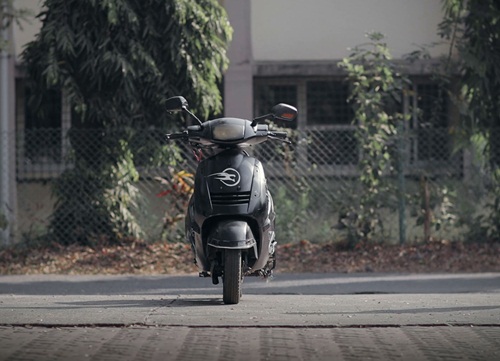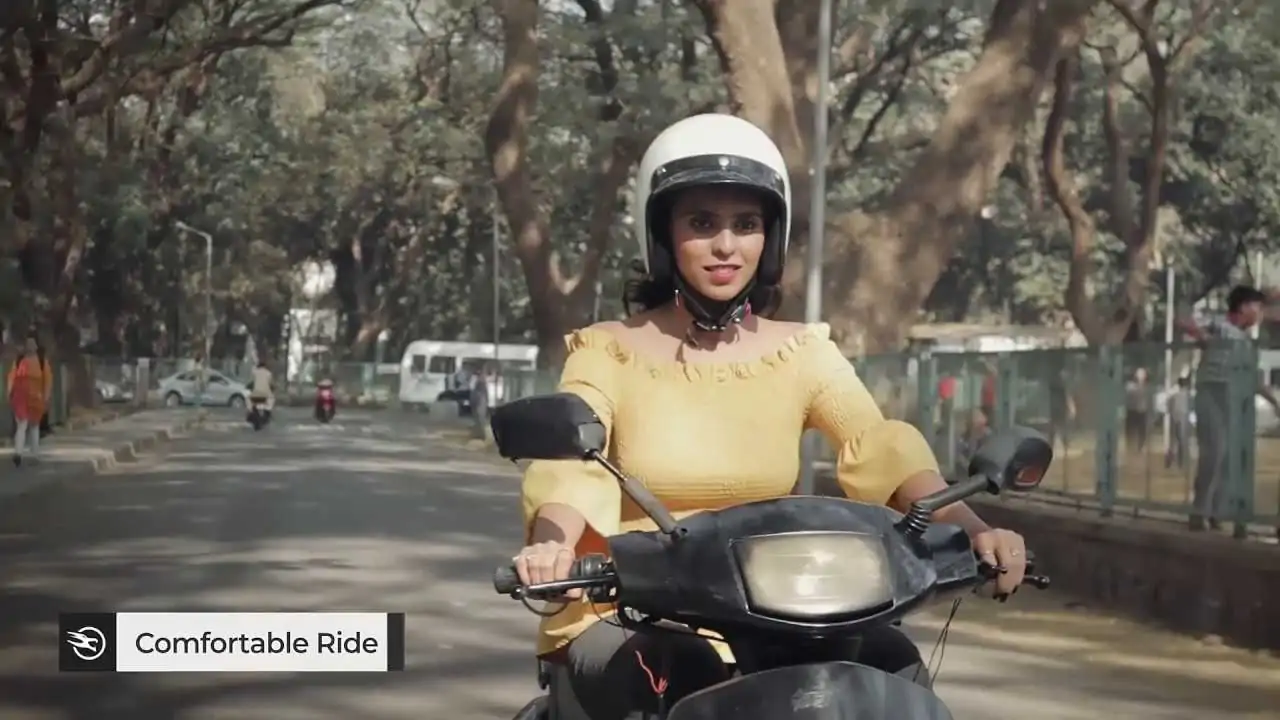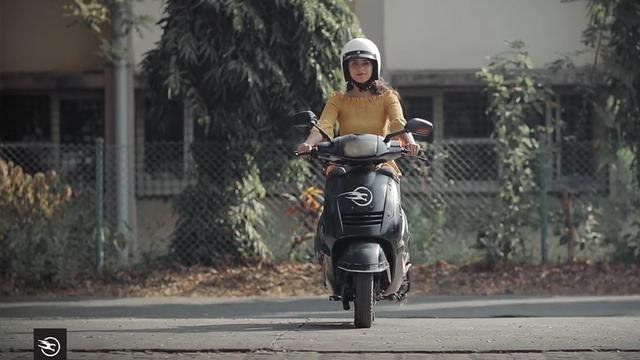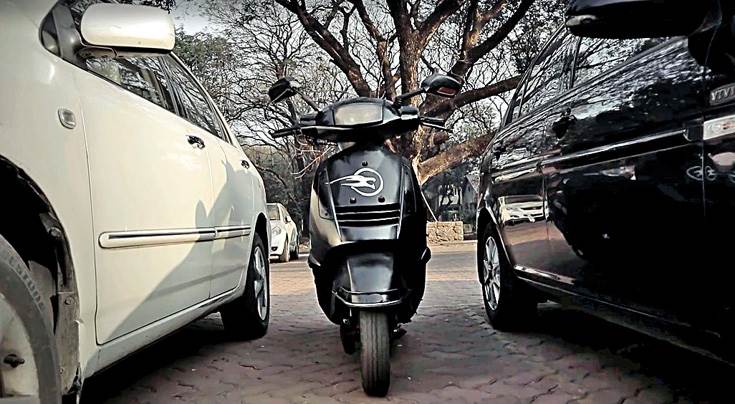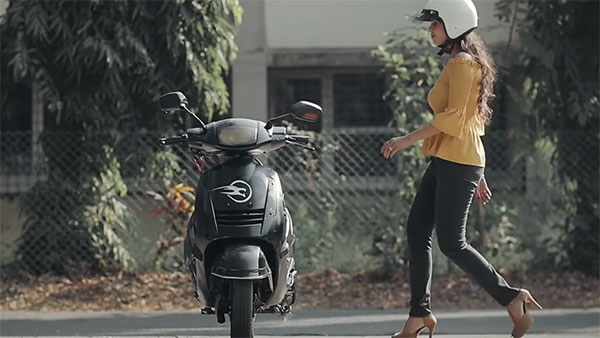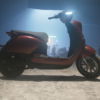TECHPRINCESS – Liger Mobility: ecco lo scooter elettrico che sta in piedi da solo

30-Dec-2019

0 Comments
Quanto sarebbe bello avere uno scooter parcheggiato in uno spazio ristretto ed essere in grado di chiamarlo e farlo venire verso di sì? Quanto sarebbe bello fermarsi a un semaforo e non dover poggiare i piedi a terra per tenere lo scooter in posizione verticale? Se tutto questo sembra fantascienza, da oggi non lo è più. Infatti la startup indiana, Liger Mobility è riuscita a realizzare uno scooter sta in piedi su due ruote da solo e, inoltre, si può richiamare verso di sè una volta che viene parcheggiato. Questo tipo di tecnologia è stata provata da altri grandi produttori come Honda, ma questa è la prima applicazione che ho visto della tecnologia giroscopica utilizzata in uno scooter di medie dimensioni. Infatti la tecnologia sviluppata da Liger Mobility ha molto più senso per uno scooter piccolo piuttosto che per una moto più grande. Gli scooter devono dare la possibilità di essere manovrati in spazi ristretti e una funzione di auto-bilanciamento renderebbe questa operazione più facile che mai. Anche un leggero impatto laterale non diventerà un problema, visto che il sistema è in grado di assorbire l’urto mantenendo lo scooter in equilibrio
Giroscopio intelligente
Liger Mobility utilizza un sistema che prevede un giroscopico abbinato ad alcuni dispositivi elettronici davvero intelligenti che inviano impulsi autocorrettivi lungo il telaio per impedire allo scooter di cadere. sia con o senza pilota. Inoltre, lo scooter, una volta parcheggiato può essere richiamato verso di sé semplicemente con un comando vocale. Per il momento lo scooter sarà proposto solo per il mercato indiano. Ma di certo questa tecnologia innovativa potrebbe attrarre l’attenzione dei grandi produttori che potrebbero proporre lo stesso sistema sui propri scooter che arriveranno sui vari mercati internazionali nei prossimi anni. Secondo la startup indiana, inoltre, il sistema può essere applicato anche a scooter già in produzione.WEBBIKEWORLD – Balancing scooter comes when you call

28-Dec-2019

0 Comments
This balancing act will amaze your friends when you call your motorbike or scooter and it automatically comes to you from its parking space. That’s a vision of the future from Indian company Liger Mobility who have developed a prototype self-balancing scooter that comes when you call it. It basically uses voice activation like Siri and it self-balances via gyroscopes controlled by microprocessors. Have a look on 10 Best Electric Scooters for Adults in 2020 that will minimise your cost of short commuting distances.
Self-balancing prototypes
It’s not dissimilar to self-balancing prototypes already developed by Honda, BMW and Yamaha. However, this scooter goes further with the ability to come when called. Apart from the carpark scenario, we can also see that this could be convenient for ageing riders or women riding in high heels who don’t want to get them dirty. However, the Bombay start-up’s claims that it will somehow be safer seem spurious.
We’re not sure of the statistics, but we couldn’t imagine too many deaths from parking incidents or falling over when coming to a stop.
The balancing act a novel display and makes a great video, but surely the extra weight and expense of gyroscopes won’t make these self-balancing scooters and motorcycles commercially viable.
Liger Mobility think it will and say it will only increase the cost of an electric or petrol-powered scooter by 10%.
That’s 10% many might prefer to spend on protective clothing!
However, the Bombay start-up’s claims that it will somehow be safer seem spurious.
We’re not sure of the statistics, but we couldn’t imagine too many deaths from parking incidents or falling over when coming to a stop.
The balancing act a novel display and makes a great video, but surely the extra weight and expense of gyroscopes won’t make these self-balancing scooters and motorcycles commercially viable.
Liger Mobility think it will and say it will only increase the cost of an electric or petrol-powered scooter by 10%.
That’s 10% many might prefer to spend on protective clothing!
BIKERSINSIDER – Liger Mobility Unveils A Self-Balancing and Self-Parking Scooter!

28-Dec-2019

0 Comments
Would it be awesome to park your scooter at a secluded space and be able to call it to come to you? What about a scooter that would sit at a stoplight without needing you to hold it upright? Well, Liger Mobility managed to create a self-balancing and self-parking scooter. Other larger companies, like Honda, tried implementing this technology. This scooter is probably the first application of such gyroscopic technology in a smaller bike. Actually, this tech is certainly more suitable for a scooter. Why is that so? Well, smaller scooters maneuver in tight spaces, and the self-balancing feature would ease up that process. Liger uses a gyroscopic device combined with some very clever circuitry to make this electric scooter work. The team that develops this bike is based in India. Also, the bike is designed with the Indian market in mind. Small scooters like this one are popular in India. This is certainly an innovative technology and something that we’re going to follow in the future. See the Liger scooter in action, in the video below!
RIDEAPART – Indian Company’s Self-Balancing Scooter Comes When You Call It

27-Dec-2019

0 Comments
When Arthur C. Clarke said “sufficiently advanced technology is indistinguishable from magic,” he probably didn’t have motorcycles in mind. This new self-balancing electric scooter from the Indian startup company Liger might be teetering on that edge, though. Unless you have a lot of experience with gyroscopic forces, this kind of thing looks like impossible science fiction. I’d be tempted to agree with you! We’ve seen this before though, from manufacturers like BMW and its self-riding GS. It is all made possible with gyroscopes controlled by microprocessors.. Note that you’ll still have to be careful with a self-balancing motorcycle or scooter like this; it will still have a “point of no return” so if you kick it hard enough while it’s parked, it will fall over. Think of the ramifications, though: a small, self-riding scooter that comes to you when you “call” it could be a great solution for city parking (protection from theft will be the next nut to crack). As it is, it will already be a great solution for riders who are losing strength as they age, or people with a disability which prevents them from riding a heavier bike, or balancing a motorcycle at all. The motorcycle-riding cohort in the United States is aging, and that is an unfortunate reality. Anything that will keep people on two wheels longer into their golden years will be a boon for the industry. Something like this scooter could also appeal to folks in a younger generation who may be intimidated by a large, heavy motorcycle. It might just be a great, friendly entrée into the sport. Unfortunately, this scooter and its team of creators are currently located in India, and their expected target market is domestic. If they find great success in their own continent, maybe we’ll see them arrive on our shores, or a larger corporation will commit to developing their own self-balancing motorcycles with more enthusiasm. The Liger scooter is not in production yet. The one in the video is a prototype. The company has not announced potential pricing yet. We’ll be keeping an eye on them, though, because this kind of magic looks like fun!
MOTORBIKEMAG – Liger Mobility India desarrolla una moto con equilibrio propio

26-Dec-2019

0 Comments
La pequeña start up Liger Mobility India ha diseñado una moto que logra mantener el equilibrio por sí sola, y que atiende a comandos de voz, pudiendo estacionar y des-estacionar de manera autómata.
Liger Mobility India es una pequeña empresa emergente, que seguramente no hayas oído, pero está logrando desarrollar conceptos que grandes multinacionales como Honda y Yamaha también andan desarrollando. El principal desarrollo tecnológico en el que están centrados desde Liger Mobility India, es nada más ni nada menos que un giróscopo instalado en un scooter eléctrico, de manera vertical, para ser sensible a las diferentes inclinaciones y así poder mandar pequeños impulsos de autocorrección a lo largo del chasis para evitar que la moto caiga a un lado o al otro. Además de lo mencionado, Liger Mobility también ha manipulado el scooter para lograr estacionar de manera autómata, y atender a peticiones por comando de voz, de modo que asiste a tu llamada totalmente sola, sin ayuda. Evidentemente esto no es ninguna novedad, de hecho ya hay vehículos Honda con este concepto y tecnología, pero no lo han aplicado a sus motos todavía.
WEBBIKEWORLD – Liger Mobility Reveals Self-Balancing and Self Parking Scooter

24-Dec-2019

0 Comments
How cool would it be to have your scooter parked away in a tight space and be able to call out to it and have it come right up to you? How nice would it be to sit at a stoplight and not have to hold your scooter upright? Well, Liger Mobility wanted to make a scooter that could stand on two wheels by itself and park itself. The small company has succeeded. This kind of technology has been tried by other, larger manufacturers like Honda, but this is the first application I’ve seen of the gyroscopic technology used in a small bike like this. This kind of technology makes way more sense for a small scooter rather than a bigger motorcycle. Small scooters need to maneuver in tight spaces and a self-balancing feature would make that easier than ever before. Liger utilizes a gyroscopic system paired with some seriously smart electronics to make the electric scooter work. This sounds like the perfect urban mobility option to me. The team that developed it is in India. It was designed for the Indian market. According to MoreBikes, the system could even be retrofitted to older bikes. Small scooters like the one Liger fitted with its tech are popular there, and it could even be seen as a safety system for riders. This is innovative tech and something I’ll be watching in the future. Check out the video below to see it in action.
MOTOCICLISMO – DALL’INDIA ARRIVA LO SCOOTER CHE NON CADE MAI

29-Nov-2019

0 Comments
Grazie ad un giroscopio il dispositivo della startup indiana Liger Mobility permette alllo scooter di bilanciare il suo peso e di stare in piedi da solo. Inoltre, grazie al controllo vocale, il mezzo risponde ai comandi del proprietario
La startup indiana Liger Mobility ha sviluppato un dispositivo in grado di bilanciare autonomamente il peso di uno scooter, in modo da permettere al veicolo di stare in piedi -anche da fermo- da solo. Il dispositivo autobilanciante può essere installato su qualsiasi scooter e come demo-bike è statoscelto un veicolo low cost elettrico. Il dispositivo sfrutta un giroscopio che, grazie ad alcuni sensori posti in posizione strategica che leggono in tempo reale la posizione del veicolo, mantiene lo scooter sempre verticale, sia con che senza conducente in sella. Inoltre, grazie a questo dispositivo lo scooter può rispondere ai comandi vocali del proprietario e muoversi in autonomia, per uscire ad esempio da un parcheggio in retromarcia. Il video pubblicato dalla startup indiana ci permette di capire meglio il funzionamento. Un sistema simile era già stato mostrato da Honda qualche anno, fa con il “Riding Assist” (qui sotto le foto). La differenza è che il progetto della Casa di Tokyo per stare in equilibrio non sfrutta dei giroscopi, ma fa affidamento su una tecnologia sviluppata internamente con l’UNI-CUB (un veicolo monoruota in grado di muoversi semplicemente spostando il peso del corpo e inclinandosi verso la direzione desiderata). Sfruttando i dati che riceve dai numerosi sensori, Riding Assist regola l'equilibrio tramite il peso stesso del veicolo, l’estensione e l’inclinazione della forcella e la rotazione delle ruote. Oltre a ciò, la differenza è che il dispositivo Liger è compatibile con qualsiasi scooter e, a detta dell’azienda, ha un costo limitato: la sua installazione su un veicolo ne farebbe crescere il costo solamente del 10%.
NEWSTRACKLIVE – Two engineers makes self-balanced scooter, will protect it from accident

26-Nov-2019

0 Comments
Two IIT passout engineers from Indore city of Madhya Pradesh have designed a self-balance scooter. It is helpful in preventing accidents due to scooter imbalance. The specialty of a scooter is that you will not need to stand on the ground to make a balance. This voice command will be controlled by your voice. Also, you will be able to park it with voice command and get it out of the parking lot. It has been prepared by Vikas Poddar, a resident of Passout Indore from IIT Madras and Ashutosh Upadhyay of Passout Ujjain from IIT Kharagpur. It is worth noting that the two together started Liger Mobility Startup in Mumbai. Vikas told Bhaskar, most of the accidents happen due to disbalance of the vehicles. We have designed this scooter to solve this problem. Ashutosh told that through our technology the scooter can balance itself, so there will be no need for the scooter to maintain the balance of the scooter with the help of feet. According to a student development, it would be easier to drive on crowded roads. The initial capital for our project was raised by the founders of Liger Mobility. We got funding in two rounds from IIT Mumbai. We are now preparing for its production and launching. In this technique, the sensors installed in the vehicle send the data processor connected to the vehicle, which uses the Artificial Intelligence algorithm. This happens more than a thousand times per second, so that the scooter remains balanced even without the stand even when it is off.
AUTOCARPRO – IIT grads develop India’s first self-balancing and autonomous scooter

17-Nov-2019

0 Comments
Even as you are reading this, someone, somewhere, in this vast country of ours, is either injured or killed in a road crash. Yes, the well-known fact is that India has one of the worst road accident records worldwide. In 2017, 464,910 road accidents were reported, claiming 147,913 lives and causing injuries to 470,975 persons, which translates into 405 deaths and 1,290 injuries each day from 1,274 accidents. Of this, a staggering 157,723 accidents involved two-wheelers, also accounting for the majority of 44,092 lives lost and 148,907 injured. That's plenty of data to infer that there’s a serious need to introduce a strong set of legislations and safety upgrades for two-wheelers and their users.
While the government and the industry are both seized of the urgency of the situation and efforts are underway through dissemination of information on road safety, introducing stiffer penalties in the amended Motor Vehicles Act and new mandatory safety technology in two-wheelers, some companies and individuals are doing their bit to make two-wheelers safer than they are at present.
True-blue engineers are keen to change the world and that's something Vikas Poddar and Ashutosh Upadhyay, co-founders of Liger Mobility, a Mumbai-based start-up that envisions development of technologies that make two-wheelers safer and provide better user experience, wanted to do. Poddar, a graduate from IIT Madras and an MBA from ISB, and Upadhyay, who graduated from IIT Kharagpur and has experience in building technology products with multiple large engineering companies in India and Europe, have a mission: to make two-wheelers safer — and in turn also save precious lives. Their focus is on enabling unparalleled human-machine interaction by leveraging core sciences and IoT in the two-wheeler realm.
In their first-ever media interaction, the founders spoke to Autocar Professional. “Both of us hail from Indore, Madhya Pradesh. If you visit any of the smaller cities, you will see that two-wheelers are the most prevalent form of mobility and much of the business is conducted using two-wheelers. We were very clear that this is the segment wherein we want to create some value. There are some obvious problems with two-wheelers — they are not safe, they are not comfortable. That's the whole sort of idea behind Liger Mobility, to do something that can actually create value for the society,” says Poddar.
Affordable tech for safer mobility on two wheels
Liger Mobility has been working on changing the dynamics of two-wheelers in terms of safety and experience for their users, without taking a toll on the customer's wallet. The start-up's self-balancing technology, which will make two-wheelers safer and riders more confident, is likely to increase the cost of the vehicle by around 10-odd percent. According to Upadhyay, “The two-wheeler per se is the primary mobility solution across India, not only in small towns but also in major cities like Mumbai, Pune and other metros. What makes two-wheelers a preferable mode of travel is good manoueverability, low maintenance and low total cost of ownership. This is why a lot of people want to use them but there are some who are not comfortable with them either.”
Adding to that, Poddar says: “There is a specific age, which once you cross, typically not many people learn to ride a two-wheeler. Between 10 to 11 years, most learn how to ride a bicycle; some who do not learn that skill, later on view the idea of using a motorised two-wheeler as a farfetched one.”
Considering 120 riders die each day in India, Liger Mobility was founded in 2016 with the goal to make two-wheelers safer and usable for everyone. News about the company's endeavour came to light recently when an investor video of its self-balancing, autonomous scooter got leaked onto social media, creating quite a buzz and more so about the incremental cost of such a technology, estimated to be around 10 percent of the cost of a two-wheeler. “As regards the cost, it's not possible to give a exactly figure right now. But it will be in, let's say, four digits (Rupees) once we go into production,” says Poddar.
“Like Vikas mentioned, cost is completely going to be dependent on the scale at which we are manufacturing. From our side, what we are focusing on is to make it as simple as possible in terms of the parts that we are using in the technology. The whole idea is to simplify it as much as possible so that manufacturing can be more and more localised. Therefore, it's not easy for us to immediately to give a cost figure,” remarks Upadhyay.
 Self-balancing and autonomous: just the start
Liger Mobility has developed a working prototype using a modified scooter, which is able to self-balance itself and also park itself, making it an easy to use experience for any user, even for someone who does not know how to ride a bicycle.
Responding to a query about the stage of development for the technology, the co-founders are quick to respond, “We are in the advanced stages of development. It’s difficult to quantify at what completion stage we are. What we can understand is that there is a product which is working, which is an advanced level. We are already in advanced prototype stage now, and the final product may be ready very soon.”
Upadhyay says, “The whole idea of giving a tentative timeline, again, comes from a lot of other factors — the funding, the kind of the collaborative kind of partnership — and committing a timeline is probably not right, at this stage. And it is a technology after all — it can always be evolving.”
For any idea to come to fruition depends upon the level of determination, perseverance and hard work of the ideator, and for any successful organisation it is the ability to stay ahead of its peers. For Liger Mobility, the idea of self-balancing technology and autonomous capabilities in the two-wheeler space, is just the start. The company at present has a core team of eight individuals including the two founders, engineers, fabricators and machinists. The plan is to expand the team, bringing in the right kind of talent that can add value to the vision of the company.
“The idea for Liger Mobility is basically not just one piece (self-balancing) that is going to come out immediately. It is to solve all these problems of how we can actually change the experience of a two-wheeler. Safety is a very big aspect, and a lot can actually be done by integrating different pieces into a two-wheeler. Self-balancing is a start, and what we have worked on is what eventually will come out in the near term. That's basically one piece of a very long-term roadmap, if you can call it that, that we that we would have. So either related to safety or the experience, eventually, even semi-autonomous is something that we are definitely looking at. Self-balancing, obviously is an enabler as far as semi-autonomous is concerned. Obviously, unless a vehicle is able to balance itself, how can it ride by itself?” queries Poddar.
Targeting shared mobility
According to Poddar, “Eventually for semi-autonomous or autonomous applications, the Liger two-wheeler will be relevant more for the shared mobility market. For shared mobility, there are very specific applications that we have in mind. It is not right to just look at the current piece of the puzzle but the entire story that's out there. Two-wheelers are not relevant just for India but for any developing country. Even developed markets are now opening up to two-wheelers. The guiding philosophy is whether you are able to create value in two-wheelers.”
Describing Liger Mobility’s vision, the founder say the thought can be summed up in one simple sentence — "Transforming the two-wheeler experience, and bringing intelligence to two-wheelers'.
When queried whether the company plans to partner with any OEM or develop a new two-wheeler itself, the Liger Mobility founders refuse comment. “It all depends on what is the two-wheeler model and the business model. Whether it's a partnership with one company or with multiple, or our own vehicles? That is something that we simply cannot discuss at this point. There's a lot of discussion, and it's simply not fair on our behalf to comment on that,” says Poddar.
Giving OEMs' enhanced activity in testing vehicles, a self-riding autonomous two-wheeler could be more suited for OEM testing purposes. Would it make sense for a riderless scooter or motorcycle heading to Starbucks without someone astride it to quaff the coffee?
As regards plans to introduce the solution first in India or explore the developed markets, Poddar says, “Logically, that makes sense (India first). But going forward, that strategy will again depend on multiple factors. Right now, that's a logical choice because India is the largest market for two-wheelers and obviously, it makes sense. But going forward, the sky's the limit, as far as this is concerned. In fact, we have received interest from over 88 countries.”
Powertrain-agnostic balancing technology
While a few self-balancing two-wheeler prototypes have been showcased by OEMs globally, including an R1200 GS by BMW Motorrad, commercial launch of such products has yet to see the light of day. One of the prime reasons for that is the high cost of such a technology that makes the end-product out of reach for the masses.
India sees over 21 million IC engined two-wheelers being sold every year. Could Liger Mobility’s self-balancing technology be adopted to these petrol-powered machines? Upadhyay says, “Our focus is not really very short-term. Petrol or electric, our technologies will be powertrain-agnostic. Wherever we can implement it, we will try to do so to enable larger number of users to benefit from it.”
As the solution is an integration of software and hardware, the technology consumes a bit of power, Liger Mobility says it is working on making it energy-efficient to address two-wheeler user concerns.
Could such a safety solution be offered as an aftermarket solution? Liger Mobility's founders say it is "hypothetically possible but the initial focus will be to bring it in a new product but nothing has been formalised yet."
ICE or electric, new or aftermarket, one thing is for sure — this start-up has a concept that has the potential to revolutionise the two-wheeler market and make Liger Mobility the next big thing from India. What is needed is a balancing act in terms of cost.
Self-balancing and autonomous: just the start
Liger Mobility has developed a working prototype using a modified scooter, which is able to self-balance itself and also park itself, making it an easy to use experience for any user, even for someone who does not know how to ride a bicycle.
Responding to a query about the stage of development for the technology, the co-founders are quick to respond, “We are in the advanced stages of development. It’s difficult to quantify at what completion stage we are. What we can understand is that there is a product which is working, which is an advanced level. We are already in advanced prototype stage now, and the final product may be ready very soon.”
Upadhyay says, “The whole idea of giving a tentative timeline, again, comes from a lot of other factors — the funding, the kind of the collaborative kind of partnership — and committing a timeline is probably not right, at this stage. And it is a technology after all — it can always be evolving.”
For any idea to come to fruition depends upon the level of determination, perseverance and hard work of the ideator, and for any successful organisation it is the ability to stay ahead of its peers. For Liger Mobility, the idea of self-balancing technology and autonomous capabilities in the two-wheeler space, is just the start. The company at present has a core team of eight individuals including the two founders, engineers, fabricators and machinists. The plan is to expand the team, bringing in the right kind of talent that can add value to the vision of the company.
“The idea for Liger Mobility is basically not just one piece (self-balancing) that is going to come out immediately. It is to solve all these problems of how we can actually change the experience of a two-wheeler. Safety is a very big aspect, and a lot can actually be done by integrating different pieces into a two-wheeler. Self-balancing is a start, and what we have worked on is what eventually will come out in the near term. That's basically one piece of a very long-term roadmap, if you can call it that, that we that we would have. So either related to safety or the experience, eventually, even semi-autonomous is something that we are definitely looking at. Self-balancing, obviously is an enabler as far as semi-autonomous is concerned. Obviously, unless a vehicle is able to balance itself, how can it ride by itself?” queries Poddar.
Targeting shared mobility
According to Poddar, “Eventually for semi-autonomous or autonomous applications, the Liger two-wheeler will be relevant more for the shared mobility market. For shared mobility, there are very specific applications that we have in mind. It is not right to just look at the current piece of the puzzle but the entire story that's out there. Two-wheelers are not relevant just for India but for any developing country. Even developed markets are now opening up to two-wheelers. The guiding philosophy is whether you are able to create value in two-wheelers.”
Describing Liger Mobility’s vision, the founder say the thought can be summed up in one simple sentence — "Transforming the two-wheeler experience, and bringing intelligence to two-wheelers'.
When queried whether the company plans to partner with any OEM or develop a new two-wheeler itself, the Liger Mobility founders refuse comment. “It all depends on what is the two-wheeler model and the business model. Whether it's a partnership with one company or with multiple, or our own vehicles? That is something that we simply cannot discuss at this point. There's a lot of discussion, and it's simply not fair on our behalf to comment on that,” says Poddar.
Giving OEMs' enhanced activity in testing vehicles, a self-riding autonomous two-wheeler could be more suited for OEM testing purposes. Would it make sense for a riderless scooter or motorcycle heading to Starbucks without someone astride it to quaff the coffee?
As regards plans to introduce the solution first in India or explore the developed markets, Poddar says, “Logically, that makes sense (India first). But going forward, that strategy will again depend on multiple factors. Right now, that's a logical choice because India is the largest market for two-wheelers and obviously, it makes sense. But going forward, the sky's the limit, as far as this is concerned. In fact, we have received interest from over 88 countries.”
Powertrain-agnostic balancing technology
While a few self-balancing two-wheeler prototypes have been showcased by OEMs globally, including an R1200 GS by BMW Motorrad, commercial launch of such products has yet to see the light of day. One of the prime reasons for that is the high cost of such a technology that makes the end-product out of reach for the masses.
India sees over 21 million IC engined two-wheelers being sold every year. Could Liger Mobility’s self-balancing technology be adopted to these petrol-powered machines? Upadhyay says, “Our focus is not really very short-term. Petrol or electric, our technologies will be powertrain-agnostic. Wherever we can implement it, we will try to do so to enable larger number of users to benefit from it.”
As the solution is an integration of software and hardware, the technology consumes a bit of power, Liger Mobility says it is working on making it energy-efficient to address two-wheeler user concerns.
Could such a safety solution be offered as an aftermarket solution? Liger Mobility's founders say it is "hypothetically possible but the initial focus will be to bring it in a new product but nothing has been formalised yet."
ICE or electric, new or aftermarket, one thing is for sure — this start-up has a concept that has the potential to revolutionise the two-wheeler market and make Liger Mobility the next big thing from India. What is needed is a balancing act in terms of cost.
Q&A Vikas Poddar & Ashutosh Upadhyay, co-founders of Liger Mobility
 How did you come up with the Liger Mobility name and what does it signify?
Liger is a rare animal that is a hybrid of a lion and a tiger, and inherits qualities from both its parent species. Drawing parallels from Liger, the self-balancing two-wheeler inherits qualities from both two-wheelers that provide convenience and four-wheelers that offer safety/comfort. Brand Liger Mobility aims to provide a superior riding experience to the consumers.
How much has been invested in Liger Mobility and by whom?
Liger Mobility has been funded by seed money from its co-founders and two rounds of investment raised from SINE-IIT Bombay.
What is the level of localisation and what is the engineering / technology behind the self-balancing autonomous technology?
In the development phase we have been focussed on building our technology with components which can give us maximum localisation. The final level of localisation will be known when we finish our groundwork on supply chain and mass production. The technology is a combination of hardware and software, and involves usage of sophisticated AI to achieve the objective of vehicle stabilisation.
Liger Mobility's solution has received considerable attention, in terms of the potential disruption that it brings for the automotive industry. Does this put pressure on your team to live up to the expectations?
On the contrary, the overwhelming response has been very encouraging, and has demonstrated the demand for our product not just in India but globally. The feedback has strengthened our conviction in the value that our technology will create for the consumer. Furthermore, this is just the beginning. We have an elaborate long-term technology roadmap, with the vision of transforming the two-wheeler experience, and bringing more and more intelligence to vehicles.
Apart from safety related solutions, what are the other factors you would want to work on?
We’re also working on autonomous technologies for two-wheelers, which will be targeted mainly at global shared mobility platforms.
How do you view the current slowdown in the automotive industry? As a start-up, how do you perceive and assess this situation for companies like yours?
The current slowdown in the automotive industry is across the board, and may be attributed to the current state of the macro-economy going through a phase of low liquidity and low growth. The tide will eventually turn for the industry and demand will pick up once the economy turns.
That said, there have been some models which have bucked the slowdown and registered growth. Therefore, this may be the best time for the industry to introspect and identify business areas where they should innovate.
As far as a self-balancing two-wheeler goes, it will in fact lead to an increase in the overall market as people who earlier wouldn’t buy a two-wheeler because they were not confident of riding one, will also have the option of switching to a self-balancing two-wheeler.
According to some statistics, 6 percent of the US population and 12 percent of the UK population do not know how to ride a bicycle. While the percentage of such people in India may be lower, the population is several times higher. If one was to extrapolate and do the math, in India alone this would lead to a sizeable new market.
What are your views on the current generation of electric two-wheelers being sold in India (Ampere, Ather Energy, Hero Electric, Tork Motors, Revolt)?
The electric two-wheeler landscape in India is fast evolving, with a number of new players entering the fray. Increased competition is always good for the consumer and we should see increased innovation in areas of product features, new technologies, business models and distribution strategies.
How did you come up with the Liger Mobility name and what does it signify?
Liger is a rare animal that is a hybrid of a lion and a tiger, and inherits qualities from both its parent species. Drawing parallels from Liger, the self-balancing two-wheeler inherits qualities from both two-wheelers that provide convenience and four-wheelers that offer safety/comfort. Brand Liger Mobility aims to provide a superior riding experience to the consumers.
How much has been invested in Liger Mobility and by whom?
Liger Mobility has been funded by seed money from its co-founders and two rounds of investment raised from SINE-IIT Bombay.
What is the level of localisation and what is the engineering / technology behind the self-balancing autonomous technology?
In the development phase we have been focussed on building our technology with components which can give us maximum localisation. The final level of localisation will be known when we finish our groundwork on supply chain and mass production. The technology is a combination of hardware and software, and involves usage of sophisticated AI to achieve the objective of vehicle stabilisation.
Liger Mobility's solution has received considerable attention, in terms of the potential disruption that it brings for the automotive industry. Does this put pressure on your team to live up to the expectations?
On the contrary, the overwhelming response has been very encouraging, and has demonstrated the demand for our product not just in India but globally. The feedback has strengthened our conviction in the value that our technology will create for the consumer. Furthermore, this is just the beginning. We have an elaborate long-term technology roadmap, with the vision of transforming the two-wheeler experience, and bringing more and more intelligence to vehicles.
Apart from safety related solutions, what are the other factors you would want to work on?
We’re also working on autonomous technologies for two-wheelers, which will be targeted mainly at global shared mobility platforms.
How do you view the current slowdown in the automotive industry? As a start-up, how do you perceive and assess this situation for companies like yours?
The current slowdown in the automotive industry is across the board, and may be attributed to the current state of the macro-economy going through a phase of low liquidity and low growth. The tide will eventually turn for the industry and demand will pick up once the economy turns.
That said, there have been some models which have bucked the slowdown and registered growth. Therefore, this may be the best time for the industry to introspect and identify business areas where they should innovate.
As far as a self-balancing two-wheeler goes, it will in fact lead to an increase in the overall market as people who earlier wouldn’t buy a two-wheeler because they were not confident of riding one, will also have the option of switching to a self-balancing two-wheeler.
According to some statistics, 6 percent of the US population and 12 percent of the UK population do not know how to ride a bicycle. While the percentage of such people in India may be lower, the population is several times higher. If one was to extrapolate and do the math, in India alone this would lead to a sizeable new market.
What are your views on the current generation of electric two-wheelers being sold in India (Ampere, Ather Energy, Hero Electric, Tork Motors, Revolt)?
The electric two-wheeler landscape in India is fast evolving, with a number of new players entering the fray. Increased competition is always good for the consumer and we should see increased innovation in areas of product features, new technologies, business models and distribution strategies.
DRIVESPARK – Self-Balancing Electric Scooter In India: Liger Mobility Electric Scooter’s Video & Details

04-Oct-2019

0 Comments
Self-balancing scooters in India could soon become a reality if this prototype is put into production. Indian electric mobility startup Liger Mobility has developed a self-balancing electric scooter with voice commands. A video by Electric Vehicle that showcases the scooter's capabilities has surfaced on the internet and it is really interesting.
 The Indian automotive market is a unique one in which there are products for everyone. There are performance motorcycles for those seeking thrills, luxury motorcycles for those seeking comfort, commuter motorcycles and scooters for those just wanting to commute.
The Indian automotive market is a unique one in which there are products for everyone. There are performance motorcycles for those seeking thrills, luxury motorcycles for those seeking comfort, commuter motorcycles and scooters for those just wanting to commute.
 In the past few years though, one segment of two-wheelers has come up and has seen massive growth. Electric two-wheelers are no longer the future but are already reality with several manufacturers competing to sell more EVs. Liger Mobility at first might seem like yet another electric two-wheeler startup that will only add to the competition in the segment.
In the past few years though, one segment of two-wheelers has come up and has seen massive growth. Electric two-wheelers are no longer the future but are already reality with several manufacturers competing to sell more EVs. Liger Mobility at first might seem like yet another electric two-wheeler startup that will only add to the competition in the segment.
 However, the team behind Liger Mobility has an ace up their sleeve - self-balancing technology. The concept of self-balancing two-wheelers is not new. Big brands like BMW Motorrad and Honda have already showcased self-balancing motorcycle before and they were really impressive.
However, the team behind Liger Mobility has an ace up their sleeve - self-balancing technology. The concept of self-balancing two-wheelers is not new. Big brands like BMW Motorrad and Honda have already showcased self-balancing motorcycle before and they were really impressive.
 Back in 2017, Honda showcased its self-balancing motorcycle at CES with advanced riding aids. Kicking it up a notch, BMW showcased a self-riding R 1200 GS in 2018. Yamaha too showcased a motobot that went against their MotoGP champion Valentino Rossi.
Back in 2017, Honda showcased its self-balancing motorcycle at CES with advanced riding aids. Kicking it up a notch, BMW showcased a self-riding R 1200 GS in 2018. Yamaha too showcased a motobot that went against their MotoGP champion Valentino Rossi.
 These motorcycles are nowhere close to production and even if they do reach the production stage, they will be way too expensive and out of reach of the common man. This is where Liger Mobility's self-balancing scooter seems pure genius.
These motorcycles are nowhere close to production and even if they do reach the production stage, they will be way too expensive and out of reach of the common man. This is where Liger Mobility's self-balancing scooter seems pure genius.
 Ashutosh Upadhyay, the co-founder of Liger Mobility, said in this particular video that their self-balancing technology will increase the cost of an average two-wheeler only by around 10 percent.
Ashutosh Upadhyay, the co-founder of Liger Mobility, said in this particular video that their self-balancing technology will increase the cost of an average two-wheeler only by around 10 percent.
 This will make it affordable and the masses can buy it, unlike the bikes from the big brands. In the video, one can even see the gyroscope moving around and working to keep the scooter stabilised.
This will make it affordable and the masses can buy it, unlike the bikes from the big brands. In the video, one can even see the gyroscope moving around and working to keep the scooter stabilised.
 The technology works very well even with the pillion rider on the scooter. Details of the electric scooter have not been revealed. The scooter itself appears to be a Mahindra Duro, with the internal combustion engine removed. The swingarm is a basic unit and the scooter is driven by a hub-mounted motor.
The scooter even features voice command for parking and reverse. The gyroscopic stability system is expected to keep the scooter upright even if it is hit by a vehicle from the side, thereby improving safety. At the moment though, it is uncertain if and when the self-balancing technology will be put into production.
Thoughts On Liger Self-Balancing Scooter In India
The biggest problem for most two-wheeler riders is to keep the vehicle balanced. Motorcycle enthusiasts wouldn't really understand this struggle because we love to ride. For us, losing balance happens only when we're pushing our motorcycles to the limit and sometimes beyond it.
The technology works very well even with the pillion rider on the scooter. Details of the electric scooter have not been revealed. The scooter itself appears to be a Mahindra Duro, with the internal combustion engine removed. The swingarm is a basic unit and the scooter is driven by a hub-mounted motor.
The scooter even features voice command for parking and reverse. The gyroscopic stability system is expected to keep the scooter upright even if it is hit by a vehicle from the side, thereby improving safety. At the moment though, it is uncertain if and when the self-balancing technology will be put into production.
Thoughts On Liger Self-Balancing Scooter In India
The biggest problem for most two-wheeler riders is to keep the vehicle balanced. Motorcycle enthusiasts wouldn't really understand this struggle because we love to ride. For us, losing balance happens only when we're pushing our motorcycles to the limit and sometimes beyond it.
 For commuters though, losing balance happens almost everyday and people hate the leg-up, leg-down exercise that we end up doing hundreds and sometimes thousands of times in heavy traffic. The Liger self-balancing electric scooter could be the perfect solution to this problem. How the production version of the scooter will look and ride is something that remains to be seen.
For commuters though, losing balance happens almost everyday and people hate the leg-up, leg-down exercise that we end up doing hundreds and sometimes thousands of times in heavy traffic. The Liger self-balancing electric scooter could be the perfect solution to this problem. How the production version of the scooter will look and ride is something that remains to be seen.

